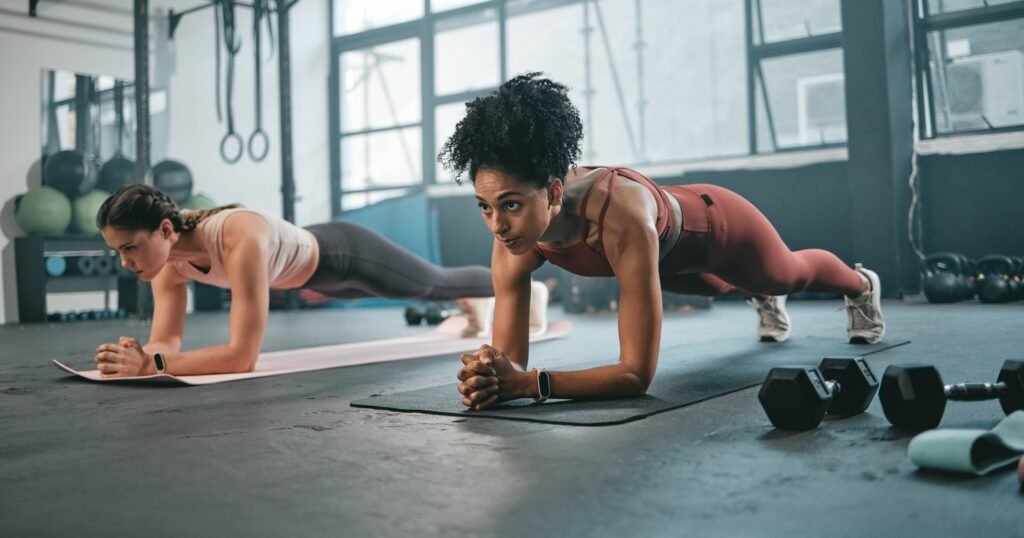Exercise has many physical and mental benefits. According to the World Health Organization, exercise can extend your life expectancy, strengthen your heart, improve your mood, and reduce the risk of minor illnesses, like the common cold, as well as other more serious health problems, like heart disease and high blood pressure. risk. But how long does it take to see results after starting exercise?
Good news: You may see some of the mental health effects of exercise right away. For example, you’ll feel good endorphins during and immediately after exercise, and being active can also help you shake off worries while exercising, according to the Mayo Clinic. However, other results require more time.
Preface: No two people’s results will be exactly the same. “Our bodies are all different and respond to exercise differently, and that’s normal,” says Chris Gagliardi, MS, ACE Certified Personal Trainer. “The important thing is to find and participate in an exercise program that works best for you.”
That being said, experts do have some insight into how long it takes to see or feel the results of exercise, depending on your goals and training. Here’s what they had to say.
Experts featured in this article
Chris Gagliardi, MS, is an ACE Certified Personal Trainer.
Guychard Codio is a National Academy of Sports Medicine (NASM) certified personal trainer and co-founder of a personal training company in New York City.
Ashley Kelley is a certified personal trainer through the National Federation of Professional Coaches (NFPT).
Ashleigh Kast is a National Academy of Sports Medicine (NASM) certified personal trainer.
Generally speaking, how long does it take to see results from exercise?
This depends on the type and amount of exercise you are doing. “The physiological changes a person notices when they first start exercising depend on the type of exercise they continue to perform,” Gagliardi said. Your body will respond to exercise if the system you’re training is progressively overloaded – meaning you’ll continue to challenge yourself no matter what type of exercise you’re doing.
However, there is a general rule of thumb for when you will see real physiological changes occur. “If done properly, exercise can lead to physiological changes in about 8 to 12 weeks for most people,” Gagliardi said. “This doesn’t mean everyone will respond to exercise the same way. Some people may see and feel results in less than 8 to 12 weeks, while for others it may take longer. Much time.
Important reminder: Many of the important adaptations your body is making are invisible. For example, some of the physiological changes that occur during cardiorespiratory training include:
- As your heart becomes healthier and pumps blood more efficiently, your heart rate will decrease at rest and during exercise
- Increased maximum oxygen consumption means your breathing is more efficient
- blood pressure drops
- Improved bone density (aka healthier, stronger bones)
- Improve blood sugar control
- Prevent metabolism from slowing down with age
Some of the physiological changes brought about by resistance training include improving or maintaining muscle mass and increasing muscle strength and endurance.
“Together, these changes result in greater physiological reserve, or work capacity, allowing you to perform daily activities with less stress and stress,” Gagliardi said.
Gagliardi adds, don’t neglect to consider the psychological changes that regular exercise can bring to you, including improved mood, reduced stress and anxiety, reduced depression, improved quality of life and better sleep.
How long does it take to notice weight loss after exercise?
Certified personal trainer Guychard Codio says if you want to lose weight through exercise, you can see results in just two to three weeks. For others, it may take longer. Certified personal trainer Ashley Kelley says her clients typically start seeing results in about six weeks.
Even though it’s possible to see changes in just a few weeks, you shouldn’t rush into action anytime soon. Cordio explains that if you want to maintain weight, you want a slow and steady process rather than an all-out effort from the beginning to try to lose weight as quickly as possible. For example, both the CDC and the Mayo Clinic recommend aiming to lose just one to two pounds per week, not more. This means that after six weeks of pursuing weight loss, it is safe to lose 6 to 12 pounds.
Keep in mind, Gagliardi notes, that you may not be able to continue losing weight at this rate in the long run. “When it comes to initial weight loss, a common goal is to lose one to two pounds per week. Initially, weight loss may be faster and feel less effortful,” he explains. But “as you begin to lose weight and improve your fitness, it may take more time, energy and effort to achieve the same level of weight loss or to prevent and reduce weight gain.”
And you cannot Lose weight “instantly” during exercise. “It’s important to note that weight changes can occur during exercise, which should not be confused with the type of weight loss that occurs gradually over time,” Gagliardi warns. “This immediate weight loss is typically The result of changes in hydration status. Follow proper hydration guidelines when exercising. “You need to drink 16 to 20 ounces of water before, during, and after exercise.”
That said, there are many variables that influence weight loss, “including food consumption and quality, level of exercise (frequency, intensity, type, duration), lifestyle behaviors (e.g., sleep, leisure activities, stress), hormonal changes, aging, and many Other factors,” Gagliardi said.
Finally, it’s also important to note that the scale is not the only indicator of weight loss progress. You can also judge changes in your body based on the fit of your clothes, the way you look in the mirror, or your body fat percentage. In fact, if you strength train, you’ll likely gain muscle, which may cause the number on the scale to go up, which is a good thing for long-term weight loss goals and your overall health, Kelly says. The more muscle you have, the easier it is for your body to lose fat and burn calories, Cordio says.
(Editor’s note: Tracking specific metrics, such as body fat percentage or even weight loss, may be triggering for some people with obesity History of eating disorders.)
How long does it take to see muscle growth after exercise?
When you first start strength training, you may think you see some muscle growth or feel instantly stronger. But this is not the result of bigger muscles. “The initial adaptation is neurological and is primarily the result of you learning how to use your muscles and move your limbs more efficiently,” Gagliardi said. “Essentially, you’re learning how to exercise and get better.” These neurological changes (which occur within the first four to six weeks of training) result in initial gains in strength rather than actual muscle growth.
Long-term adaptations — such as increases in muscle size, strength, endurance and power — may begin to occur within eight to 12 weeks, he said.
Generally speaking, muscle growth is a slow (but rewarding!) process. Studies have found that gaining 0.5 to 2 pounds of muscle per month is a good estimate maximum Healthy adult men can achieve muscle growth through good nutrition and consistent training. While this study only looked at adult men, other studies have shown that changes in muscle size and strength caused by resistance training vary by individual, not gender. This means that, regardless of your sex at birth, 0.5 to 2 pounds per month may be the “upper limit” for maximum muscle growth.
As with weight loss, exercise isn’t the only factor that affects strength gains. In order to see muscle growth, you also need to consume enough carbohydrates and protein so that your body has the necessary fuel to repair and rebuild muscles after training – the process that leads to muscle growth. As a result, certified personal trainer Ashley Custer points out that people who weight train without focusing on nutrition will have a harder time achieving and maintaining results. If you’re concerned about nutrition when trying to gain muscle, talk to your doctor or registered dietitian for guidance.
Bottom line: Exercise results run deeper than you meet
“It’s important not to compare yourself to others and their rates of change, but instead focus on how exercise changes you physically and mentally, as well as other benefits you may experience,” Gagliardi says. Remember , aside from any obvious changes you might see, how good exercise is for your overall health (both mental and physical).
As with making changes in any aspect of your life, Kelly points out, “If you do something consistently and wait at least 21 to 42 days, you’ll see changes.”
Lauren Mazzo is PS’s senior fitness editor. She is a certified personal trainer and fitness nutrition expert by the American Council on Exercise. Prior to joining PS, she spent six years as a writer and editor at Shape magazine, covering health, fitness, nutrition, mental health, sex and relationships, beauty and astrology.
Samantha Brodsky is a former assistant editor at PS. She uses her background as a gymnast to cover her sports and fitness coverage, and provides support via Peloton videos in her free time.

